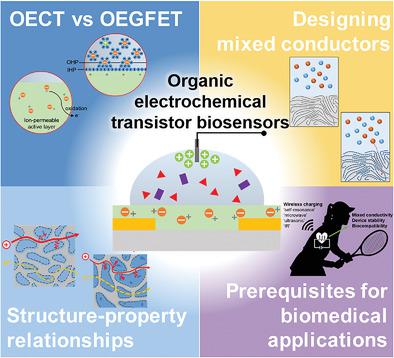当前位置:
X-MOL 学术
›
Macromol. Biosci.
›
论文详情
Our official English website, www.x-mol.net, welcomes your
feedback! (Note: you will need to create a separate account there.)
Designing Polymeric Mixed Conductors and Their Application to Electrochemical-Transistor-Based Biosensors.
Macromolecular Bioscience ( IF 4.4 ) Pub Date : 2020-08-26 , DOI: 10.1002/mabi.202000211 Ji Hwan Kim 1 , Seong-Min Kim 2 , Gunwoo Kim 1 , Myung-Han Yoon 1
Macromolecular Bioscience ( IF 4.4 ) Pub Date : 2020-08-26 , DOI: 10.1002/mabi.202000211 Ji Hwan Kim 1 , Seong-Min Kim 2 , Gunwoo Kim 1 , Myung-Han Yoon 1
Affiliation

|
Organic electrochemical transistors that employ polymeric mixed conductors as their active channels are one of the most prominent biosensor platforms because of their signal amplification capability, low fabrication cost, mechanical flexibility, and various properties tunable through molecular design. For application to biomedical devices, polymeric mixed conductors should fulfill several requirements, such as excellent conductivities of both holes/electrons and ions, long‐term operation stability, and decent biocompatibility. However, trade‐offs may exist, for instance, one between ionic conduction and overall device stability. In this report, the fundamental understanding of polymeric mixed conductors, the recent advance in enhancing their ionic and electrical conductivity, and their practical applications as biosensors based on organic electrochemical transistors are reviewed. Finally, key strategies are suggested for developing novel polymeric mixed conductors that may exceed the trade‐off between device performance and stability.
中文翻译:

设计聚合物混合导体及其在基于电化学晶体管的生物传感器中的应用。
采用聚合物混合导体作为活性通道的有机电化学晶体管是最突出的生物传感器平台之一,因为它们具有信号放大能力、低制造成本、机械灵活性以及通过分子设计可调的各种特性。为了应用于生物医学设备,聚合物混合导体应满足几个要求,例如优异的空穴/电子和离子导电性、长期运行稳定性和良好的生物相容性。然而,可能存在权衡,例如,离子传导和整体器件稳定性之间的权衡。在这份报告中,对聚合物混合导体的基本理解,提高其离子和导电性的最新进展,综述了它们作为基于有机电化学晶体管的生物传感器的实际应用。最后,提出了开发新型聚合物混合导体的关键策略,这些导体可能会超过器件性能和稳定性之间的权衡。
更新日期:2020-08-26
中文翻译:

设计聚合物混合导体及其在基于电化学晶体管的生物传感器中的应用。
采用聚合物混合导体作为活性通道的有机电化学晶体管是最突出的生物传感器平台之一,因为它们具有信号放大能力、低制造成本、机械灵活性以及通过分子设计可调的各种特性。为了应用于生物医学设备,聚合物混合导体应满足几个要求,例如优异的空穴/电子和离子导电性、长期运行稳定性和良好的生物相容性。然而,可能存在权衡,例如,离子传导和整体器件稳定性之间的权衡。在这份报告中,对聚合物混合导体的基本理解,提高其离子和导电性的最新进展,综述了它们作为基于有机电化学晶体管的生物传感器的实际应用。最后,提出了开发新型聚合物混合导体的关键策略,这些导体可能会超过器件性能和稳定性之间的权衡。











































 京公网安备 11010802027423号
京公网安备 11010802027423号